Japanese people living in Sulawesi in the early 1900s
During the Meiji period in the mid-19th century, there were surprisingly many Japanese men with great dreams who sailed out of Japan. So why did many of them head for the South Seas and Celebes (now Sulawesi)….. places where so many things such as historical background, climate and life style were completely foreign to them?
The young men adventured out to the “South Seas” due to their poverty or ambition, but also migration was encouraged by the Japanese government and entrepreneurs kept watchful eyes on the development of the South Seas.
The last half of nineteenth century saw the peak of Imperialism. By 1876, more than fifty percent of the entire Asian nations were colonized. Under such circumstances, Japan felt a greater threat from the European nations. In 1887, a geologist Shigetaka Shiga published the records of his ten-month experiences on a training ship of the naval academy whose purpose was to inspect the South Sea Islands and Australia. The book is called “Nan-Yo-Jiji (The affairs of the South Seas)”. His thesis encouraged Japanese migration aiming for the breakdown of insular island mentality and merging the cultures of East and West to create a unique civilization of New Japan. It naturally drew attention to the undeveloped South Sea Islands – the place where neither Eastern nor Western influences had reached, yet an abundance of resources existed. It also provoked those who dreamed of quick fortune and the ones who found development of the South Seas to be Japan’s mission. Their action of crossing the Pacific Ocean ignited the boom of South Seas advancement.
Menado (now Manado)
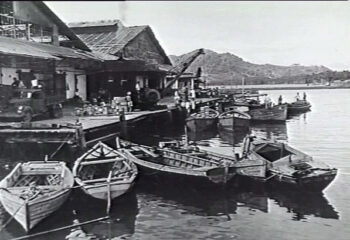
Let’s catch a glimpse of the port town, Menado, which is now commonly known as Manado. The name is derived from the Minahasan language ‘Manadou’ or ‘Wanazou’ meaning ‘on the far coast’, referring to the further two islands which can be seen from the mainland. Some say that the name Manado evoked nostalgia to the Japanese immigrants because it reminded them of a Japanese word Minato-harbour.
Manado is located on the north-eastern end of North Sulawesi Island, previously known as Celebes. It is the political, economic and cultural hub of the Minahasa region of Northern Sulawesi and it boasts a fine natural harbour but as ships became larger the main port activities shifted to the east coast at Bitung. Manado was a trading centre for copra and spices. In Manado, Christianity permeated through the islanders early during the period of Netherlands colonization and the majority of Manado residents are still Christian. In the early 1900’s it was a common scene on Sundays to see men in white suits and neckties and women in white dresses riding on a carriage pulled by a pony to attend a church.
Japanese residents in Manado in 1916 numbered only about 30, most of whom were engaged in carpentry, running general stores and selling medicines. Around the 1920’s when various Japanese agricultural companies advanced extensively, Nan-Yo Boeki Co., Ltd and private plantation managers acquired vast areas of coffee and palm tree plantations and actively purchased copra. The 1930’s saw the advancement of Japanese fishing companies in Bitung and the number of Japanese residents in the Minahasa region including Manado increased to 372 in 1938. The Consulate General of Japan and Japanese Association with 191 members and the Manado Chamber of Commerce were also established. Although the Japanese economy suffered due to the global depression and the American economic blockade against Japan, the 1930’s was a prosperous period of Japanese expatriate enterprises.
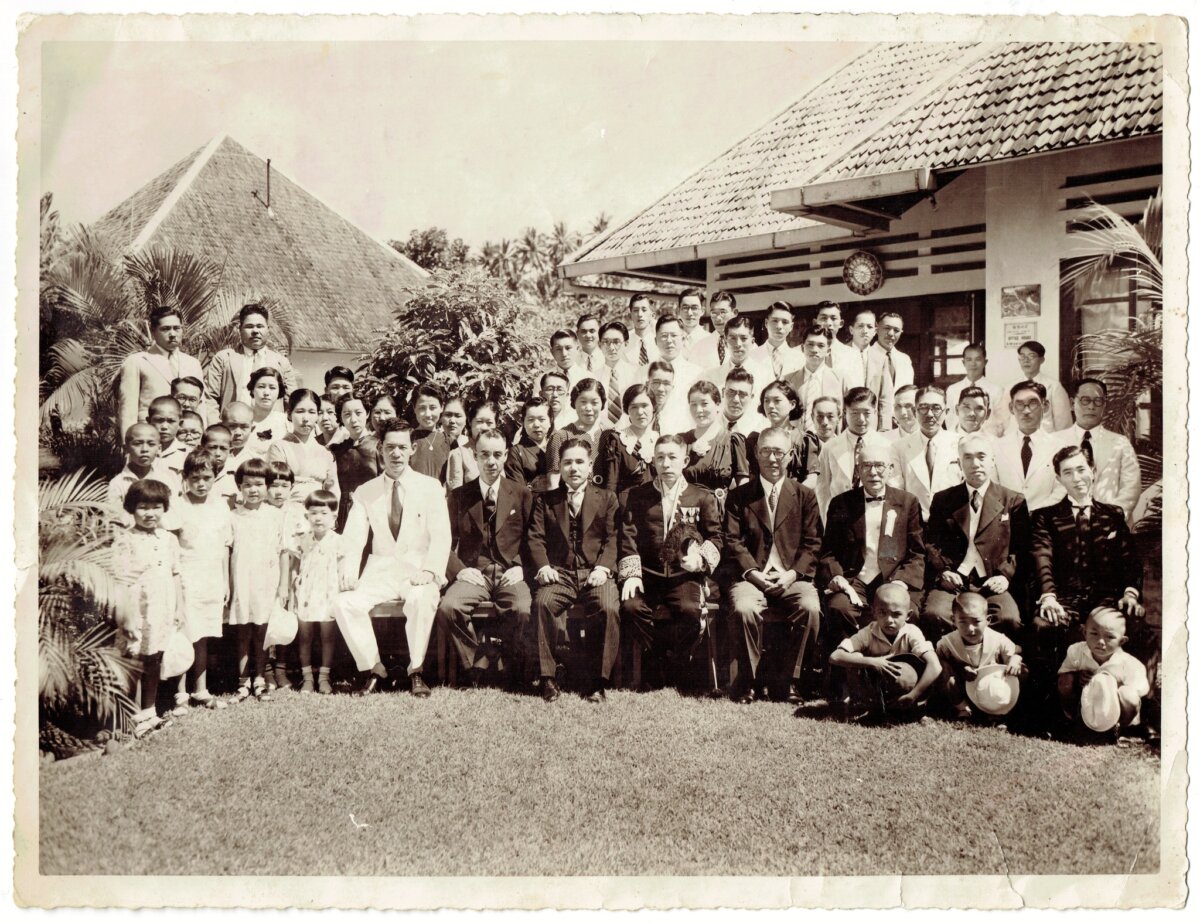
In 1938 the Japanese Association compiled a list of Japanese nationals who were living in North Sulawesi. HERE is the original list. And HERE is the translated list
On the other hand, a rapidly increased population of Chinese merchants from the late 19th to the early 20th century was also influential. It is recorded that out of the 10,344 population of Manado in 1905, Europeans including Japanese accounted for 576 (The Japanese were counted with Europeans after Japan acquired this status as allies with the West after World War 1). The Chinese amounted to 2,784, other Asians 15, Arabians 300 and the local islanders 6,669. A similar ratio of European/Japanese and Chinese population was seen in Makassar, the chief port town in Southern Sulawesi, which clearly indicates the financial influence of the Chinese.
“The number of Japanese immigrants in Dutch East Indies is insignificant. The most of retail and trading businesses are in the hands of Chinese merchants whose number exceeds a total of one million in Java and Sumatra.” Special correspondent, Maynard Owen William, National Geographic 1940.
Shortly after Japan opened its door to the world after the Meiji Restoration, while almost being swallowed up by the ambitions of Western powers in the turbulent situation of the world, Japan integrated Western industrial technology with Japanese traditional skills and succeeded to establish its economic status with the West. In 1874 (Maiji6), close to 80% of Japan’s employment was still related to farming. It is extraordinary that it only took thirty years after that for Japan to rise to the equal industrial status with the Western powers.
There is a saying “Samurai’s Spirit and a Merchant’s Aptitude”, which was advocated by Eiichi Shibusawa, a former samurai who became the well-known industrialist. Meiji frontier spirit linked samurai code of conduct, based on Confucianism, with economic activities. It condemned unethical merchants who pursued only their own profits. This spirit diligently encouraged the common good as well as creating a new reality with innovative vision. It was this Meiji spirit which many Japanese men lived with, putting all their energy into the development of the South Seas.
Significant Japanese people in Celebes (Sulawesi)
Gunta Yamazaki
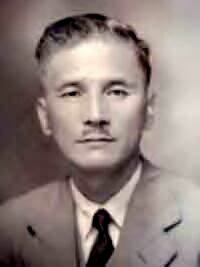
Born in Nagasaki in 1894 (Meiji27), Gunta’s ambitions went beyond the small island of Japan. His eyes were set on the South Seas. As an employee of Nanyo-Boeki Co., Ltd in 1917 , together with his newly-wed bride Michiko, he was transferred to Manado. For the first ten years, as a director of the Manado branch, he managed trading, transportation, fishery, mining and oil manufacturing with enthusiasm and a challenging spirit while running his own coffee plantation. After having taken the role of the Japan Association chairperson, he left for Japan in 1927. He then returned to the Palau Islands in 1934 as the General Branch Manager and Resident Director of the South Seas and then back to Celebes. He was known as a notably successful entrepreneur.
There is an essay journal called “The big-hearted ocean of Sulawesi: A gift from my grandfather” written by Gunta’s granddaughter, Keiko Yamazaki. It is a warm-hearted recount of their adventure in Celebes and of memorable interactions with the Indonesian people which were mediated by a tribal sword that had been given to Gunta from a respected man of Minahasa before the war. It is a must read and we are trying to find a copy to link to on this web site.
Isamu Oiwa
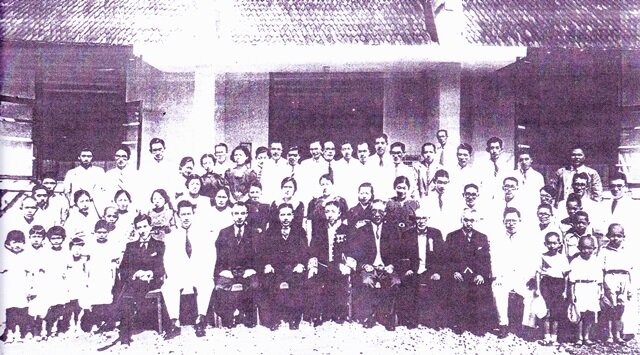
Isamu Oiwa was born in 1902 in a town called Shin-Ko-Yasu. Prior to leaving Japan, his hometown was Toyohama in Aichi prefecture where his father ran steel, lumbering and shipbuilding businesses.
So with his carpentry and shipwright skills, in 1929 he headed to Palau and worked as a shipwright for three months, and then moved onto to Moluccas, the original Spice Islands for two years, then moved to Bitung and founded the Oiwa Fishery & Shipbuilding. Those days, only a few people lived in Bitung which only had 11 houses. He ended up employing many Japanese and Indonesian people and the village soon prospered into a bustling town of 400 houses which became renowned for it’s bonito fishery.
Mr Oiwa’s contribution to the town was so significant that it is not an exaggeration to say that without him, the Bitung of today would not be the same. He has descendants still living in Bitung as well as Japan.
Kando Miyaji
On the north side of the Manado river, across from a Japanese cemetery was the residence of Kando Miyaji. Mr. Miyaji built a Japanese primary school within his property and took on the role of principal.
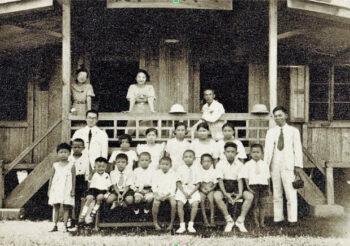
The building and education cost of this school had been funded by the Japanese Ministry of Foreign Affairs in 1936 and it was run by Japanese Association with 191 members. It is recorded that out of 19 students, 16 lived in a school dormitory and 15 who had Minahasan mothers could not understand much Japanese at all. Mr. Miyaji was the principal and Minoru Yanai, an expatriate Japanese merchant in Manado was representing the patron, The Celebes Japanese Association.
Mr. Miyaji who had established a publishing company, Sakushin-Sha in Shanghai spent a passionate thirty years as he significantly contributed in regards to China policy, economics and education through his countless articles and lectures. During the same period, he also completed a multiple-purpose residence and training centre called Sei-Min Ro in Setagaya, Japan for researching agricultural economics, training personnel and lecturing. His dedicated character to human education, beyond an egoistic view of self and others, surfaces here again.
It was 1934 when Mr. Miyaji took notice of the potential for growing cotton in Celebes Island and arrived at Manado after having declared that he had written his last article on his popular newspaper. Minoru Yanai, as director of Futaba Co. (later merged with the nationalised company Nan-Taku) helped Mr. Miyaji develop a cotton plantation where Mr. Miyaji devoted all his energy into creating an excellent variety of cotton named “Miyaji Cotton”. Upon his return to Japan in 1939, the right to use the original seeds of Miyaji Cotton, tangible property and the plantation were transferred to Futaba Co. (Nan-Taku Co., Ltd)
In order to fulfil Mr. Miyaji’s wish to succeed this excellent variety, Nan-Taku built a cotton factory in Gorontalo (200 km South-West of Menado) where raw cotton was exported to Japan. US air raids during World War, however, destroyed these facilities.
We do not have any photographs of Mr Miyaji but this is his wife, Kei standing next to the son of the Japanese merchant trader in Manado, Minoru Yanai.
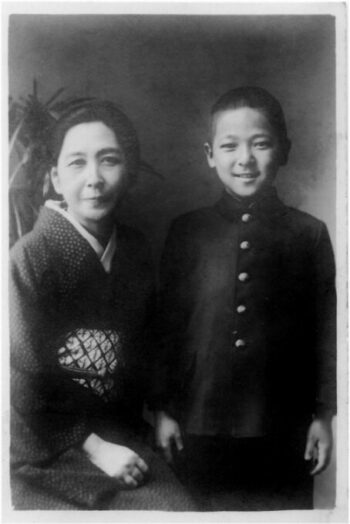
Minoru Yanai
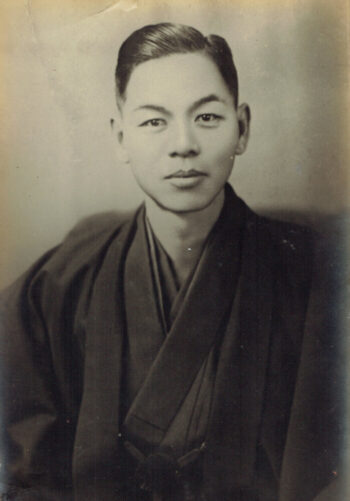
Minoru was born in Himeji city, Hyogo Prefecture on the 13th February 1900 and married Chiyo Kiyose on the 22nd of May 1924. In 1928, they departed Kobe Port and arrived in Manado to start a new life.
He founded Futaba & Co with his office at the Manado wharf near the Hotel Celebes Importing general goods and exporting Copra. He also established a coffee plantation in Sindoran, to the east of Kakas.
He was very actively involved in the Manado Japanese Association which included organising the construction of the Japanese School in Manado.
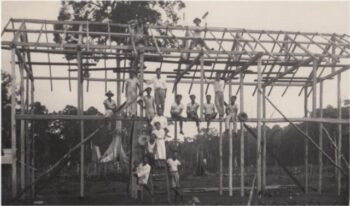
Minoru was also instrumental in organising the opening of the office of the Consulate General of Japan in Menado in 1938 and in the same year his company was nationalised by the Japanese government. Futaba & Co was merged into Nanyo Takushoku Co Ltd. (thereafter Nan-Taku).
In 1939, with international tensions developing he repatriated his wife Chiyo and four children to Japan.
Mr Miyaji (details above) had transferred the rights to use original seeds of Miyaji Cotton and cultivation land to Minoru’s Futaba & Co but as a result of WW2 this project never progressed.
Lets take a look at the Japanese who settled in other parts of the “South Seas”.
Amongst these adventurers were the albatross hunters who dreamed to fetch big money by exporting to US. They expanded their territory from Tori-Shima, a part of Tokyo, to Midway Islands and North-western Hawaiian Islands. Meanwhile, an increased number of Japanese migrant laborers advanced further to the South Seas including the relatively close Philippines. Then some crossed the equator to the sugarcane farms in Queensland and to Thursday Island and Broome in Northern Australia as pearl oyster divers.
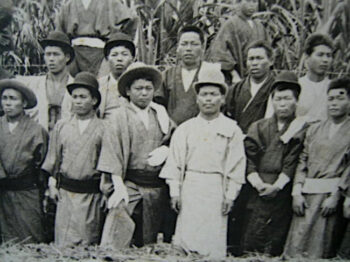
The Japanese divers who had been fishing pearl shells since 1870 in a country town called Cossak in Western Australia moved 800 km north to the port town of Broome in the 1880’s. By 1900 Japanese divers exceeded 2000, most of whom came from Wakayama prefecture south western Japan. Now there is a memorial monument for 919 Japanese divers at the Japanese cemetery in Broome. It was also from Wakayama that many boat builders and fishermen settled in Bitung in North Sulawesi
Thursday Island and Tomitaro Fujii
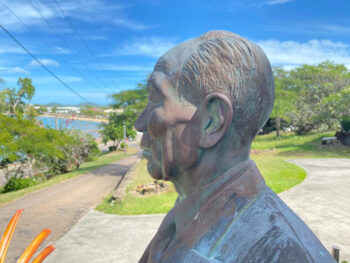
There is a bronze statue of a man quietly standing on a hill near the wharf on a small island called Thursday Island located in the Torres Straits in the Arafura Sea where a lot of wealth had been made by divers. The statue is for Tomitaro Fujii. In 1925, he left his hometown in the Wakayama prefecture at the age of eighteen and arrived in Thursday Island as a diver. He was one of the 700 Japanese divers who had dedicated their lives to fishing pearl oysters, Takase shells and sea cucumbers whilst working with the villagers to develop their fisheries from 1878 till 1941. So, why is it that the majority of Japanese workers came from Wakayama prefecture to engage in fishery in Australia and the South Islands? It is believed that the necessity due to poverty in the South Wakayama with a shortage of farming lands played a big part of the reason. The highly skilled divers from Wakayama in the Kii Peninsula had been used to the merciless sea and had never been bothered by the harsh conditions of diving. Their diligent nature was perfectly suited to these conditions. The Wakayama people who engaged in many retail activities such as importing bicycles at Makassar in the Celebes Island in the 20th century were the former divers who had migrated there from Thursday Island.
Pearl oyster fishing had originally been conducted by Australian Aborigines and Caucasians. However, 60 percent of divers were Japanese by 1897, then 99 percent by 1926. Some of the Japanese divers ended up becoming managers of the pearl fisheries. This monopolised market caused an anti-immigrant movement. The declining market due to the global depression of 1931 forced Japanese divers to be dismissed. In 1941 at the breakout of the war, all Japanese residents on the island were arrested by Australian government and most of them were deported to Japan after the war. Some Japanese who were married to Australians returned to Thursday Island and resumed pearl industry. However, as the plastic buttons became popular, the demands for costly shell buttons declined until the pearl industry on Thursday Island ceased to operate.
Mr. Fujii, whose statue now looks down over the Torres Straits from the hill, returned to Thursday Island after the war and dedicated the rest of his life to the pearl industry till 1986. The locals called him “Father of the Pearl” with admiration.
Iheiji Muraoka
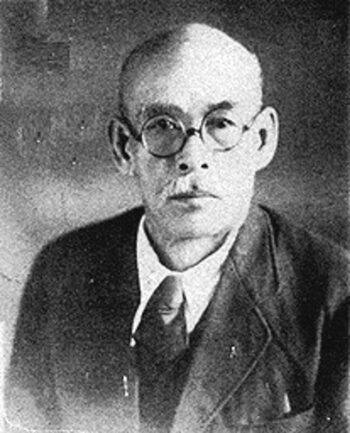
In addition, there was another daring, fervent Japanese man named Iheiji Muraoka. He was born in Nagasaki in 1867. The penniless eighteen-year-old young man jumped around across Hong Kong, China, Singapore, Calcutta, Hanoi, Taiwan and the East Indies (current Indonesia). He pursued any work he could think of, legal and illegal, including inns, restaurants, barbers, brothels, general goods peddler, interpreting, fishing pearl oysters and sea cucumbers, vegetable farmer, mediating labourers, medicine, making sweets and casting gold coins. At the age of thirty, he was married to a princess of the Toraja tribe in Celebes Island and made his way to become King before ending his life of seventy six years in the Philippines during the war in 1943. (Reference: “Japanese advancement to the South in 1890s; From Iheiji Muraoka’s autobiography” Written by K Wakita www5d.biglobe.ne.jp/makassar/mks/muraoka.html)
Shokichi Umeya
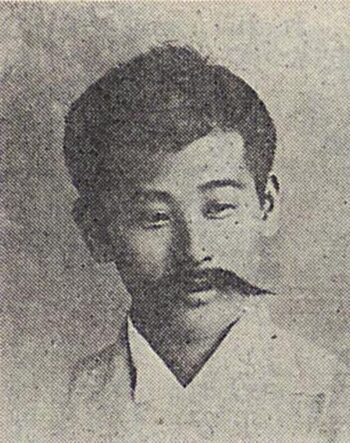
A rowdy boy, Shokichi Umeya, was born in Nagasaki. In 1894, he left Japan at the age of twenty-five and opened a photography business in Hong Kong. This is when he met the Chinese National Revolutionist, SunYatsen. After returning to Japan, he became a founder of Japan Film in 1909. Shokichi continued all his life to support Sun Yatsen morally and financially by hiding him at home while in exile and organising his wedding at Umeya residence and by continuing to spend a large amount of money form the film industry on the revolutionary movement of Sun Yatsen.
Shokichi (left) with Sun Yatsen It was 1894 when Shokichi presented his ideas “Plan for trading with and migrating to the South Seas”. It advocated Japan to become a leader of reforming Asian nations which had been threatened by European Powers, starting with Japanese immigrants to be sent to Siam (now Thailand) as mine workers then to further liaise with East Asian nations.
Shokichi appealed to politicians in Japan and actualised an inspection visit to Singapore and founding of South Seas Trading Firm in Tokyo. His influence to the Japanese advancement to the South was significant.
Haruji Matsue
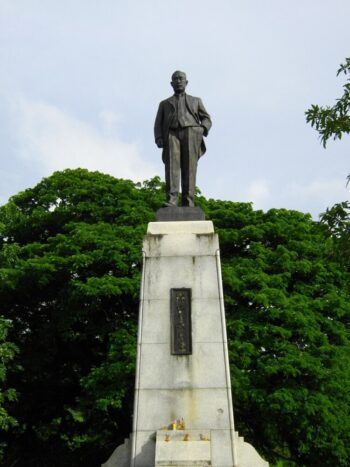
A businessman called Haruji Matsue was the first Japanese who made cube sugar and attained the name “Father of South-Sea Development”. Mr Matsue who arrived in Saipan, Japan’s newly mandated territory after the WWI, with Okinawan labourers had a brilliant mind and skills along with an indomitable spirit. He hired Koreans who had been left behind on the island and they all engaged in clearing land, planting sugar canes, building railways for transferring sugar canes and founding a whisky distillery.
At the beginning of the 1910’s, Japan rode on the upswing of the market and many enterprises advanced to China, Taiwan and the inner South Sea. However, due to the 1920’s recession, Saipan had more than 1,000 Japanese immigrants who suffered from unemployment and starvation. The Japanese government feared the international criticism of the terrible state in the Japanese territory and immediately carried out emergency transportation of food, then the nationalised company, Nanyo Kohatsu Co., Ltd, was established in 1922 (Taisho 11). Mr Matsue was appointed as the president and expanded its business into distilling, mining, fishery, agriculture and transportation. He made a great contribution to the development of the colonization enterprise in the South Seas to the extent that more than twenty affiliated companies were founded in the areas including Palau, Truk Island, Philippines and New Guinea by 1938.
This was how Japan moved from the “Adventurous Period” in the South Seas in the Meiji and Taisho eras to the “Nationalised Company Period” before and during the WWII and development of the South Sea became more politically inclined.
Post First World War Territories
After the First World War, Germany lost all of its overseas colonies. As a result, Japan, one of the Allies, was entrusted the governance of the Class-C mandate of the former German New Guinea, north of the equator, in the Treaty of Versailles in 1922 (Taisho 11).
These mandated areas, 623 Micronesian islands of 2149 square metres in total (current Mariana Islands, Palau, Marshall Islands and Federal of Micronesia) were called “South Sea archipelago” or “Inner South Seas”. The outer islands which remained with other colonial powers and included the Philippines, Borneo, Java, Singapore, New Guinea, Solomon were called “Outer South Seas”.
The following month in 1922, Nan-Yo Cho, the government office of the mandated South Sea Islands, was established by the Japanese government and it took over the administrative duty from the navy. The head office was located in Koror Island in the Palau Islands and the branch offices were divided into 6 districts in Palau, Yap, Saipan, Truck, Ponape and Jaluit. The Governor General of Non-Yo Cho held the highest authority, yet the navy retained its actual power by placing a military attaché.
Education of the Japanese language to the local people had been conducted by naval officers under the military administration until 1922. After the civil administration was established, Nan-Yo-Cho placed a ‘School for Islanders’ in six islands and professional teachers were sent from Japan. As a part of occupation policy, Japanese education was considered crucial as “Japanisation Education”. A group of selected intelligent Indonesian children were sent to Japan and educated to assimilate to the way of Japan. Shinto shrines were built at Japanese towns in the colonies and, as well as migrated Japanese people, the islanders were made to worship. Forcible policies which ignored indigenous customs and Christian influences and favourable treatment of Japanese labourers compared to the islanders attracted criticism from the islanders and European nations as a possible violation of one of the Governance Articles.
Japanese colonial policies prioritised its economic development including exploitation of the natural resources such as iron ore and crude oil, exportation of the labour force as well as Japanisation of islanders and establishing the superiority of the strategic military force. This alone shows how rapidly Japan’s development in the South Seas, with strong signs of military governance under the civil administration, was progressing with the establishment of nationalised companies. Under such circumstances, Japan plunged towards the Pacific War with the slogan “Establishment of the *2 Great East Asia Co-Prosperity Sphere”.
*2 Great East Asia Co-Prosperity Sphere : Ideology to free China and South East Asia from the control of European Imperialism and to build a broad economic sphere where Japan is the leader of the prosperous coexistence.
Indonesia and Japanese merchants before the World War II
Among the South Sea Islands, the Dutch East Indies, now Indonesia, was where Japanese migration occurred the earliest other than Singapore and the Malay Peninsula. As with other nations, the majority of the initial Japanese migrants to Dutch East Indies around 1880 were female prostitutes called “Kara-Yuki san” (Lit. Foreign- country-goers). Many were from Kyushu Island, south of Japan.
Their migration was encouraged as a vanguard of foreign currency earners to Japan’s benefit. Their migration to the South Seas naturally initiated the opening of Japanese general stores of daily necessities such as kimono, groceries and medicines. In the 1910’s, Japanese migrants increased rapidly – the majority of which were the retail store managers called Toko Japan. Particularly popular medicine peddlers indicate a close connection to Kara-Yuki san who were in need of medications such as cold remedy, tooth paste, headache medication, eucalyptus oil and peppermint for their health and welfare. Various industrial products such as chemicals, mechanical products and transportation products were sold, as well as pottery and paintings in the urban area.
In the 1920’s, many plutocracies, entrepreneurs and individuals advanced into the South Seas one after another for the business of farming, trading, marine transport, fishery, forestry or finance. And this trend led to the next phase of the business management by general trading corporations.
The number of Japanese residents in Dutch East Indies alone were as follows; total of 614 people in 1909 (166 males and 448 females) 3,103 (male and female equal) in 1915 during WWI and 7,195 in 1930.
Celebes (now Sulawesi)
This equatorial island consists of many volcanoes and lakes. Its central region forms a steep and complex mountainous range. Due to the difficulty of crossing the range, a unique culture remained in each region. There still exists more than seven tribes including Toraja, Gorontalo and Mori tribes. Their unique customs and multiple languages are maintained and the life style of hunting and farming under the hot and humid tropical monsoon climate has been carried on.
The Dutch East India Company advanced into Java in 1602 and colonization of Indonesia by the Dutch expanded. In 1669 a treaty regarding the ruling of Celebes Island was concluded and after the dissolution of Dutch East India Company in 18th century, the ruling of the colony was handed over directly to the Netherlands itself.
The purely self-interested colonial policy brought the Netherlands immense wealth, however, in the early 20th century, they began to witness poverty in the entire island due to their harsh exploitation. A rapid decline in the standard of education, industries and living standards in general for the local Indonesians was apparent. The policy was shifted in order to recover the colonial economy by improving the welfare of local residents. Among the pro-Netherlands elite locals, some received professional education in Dutch language in areas such as government administration, economics and medicine. Some even took part in governance of the colony under the instruction of the Dutch officers. Nevertheless, the majority of local residents received the opportunity only for elementary education.
Another notable fact was that the commercial activities in Celebes Island were quickly invigorated by migrated Chinese merchants from the late 19th century, and they made a tremendous growth by 1920. The main source of their income was from plantation agriculture in the fertile land for coffee, corn, sugar cane, tobacco and coconut palms as well as carpentry, fishery and trading. Celebes Island was also rich in underground mineral resources such as iron ore and nickel. Newly built main roads and railroads in Makassar and Manado allowed transportation of the resources easier and smoother.
In 1915, a few years before Japanese Nan-Yo Cho (the government office of the mandated South Sea Islands) was established, Nan-Yo Kyokai (the South Seas Association) was founded. One of the places which the association targeted to develop was Celebes Island. Its purpose was ‘to research the current circumstances of the South Seas, to develop their resources and to promote the welfare of both Japanese and the locals.’ Since the association was requested, by the Ministry of Foreign Affairs of Japan, to promote the South Seas colonial policy, it underwent a structural change from the initial ‘semi-governmental body’ to an ‘affiliate body of national policy’.
In 1914 during Japan’s military administration, there were only less than 100 Japanese residents in the South Seas, then it increased to 70,000 by 1934; double the total number of the local islanders. This fact alone indicates an intense advancement of Japan’s nationalised companies under the name of ‘South Seas Development Policy’. The three main pillars of the nationalised companies in the colonised South Seas were Nan-Yo Boeki (Founded in 1906, A trading company between Japan and the South Sea Islands), Nan-Yo Kohatsu (Founded in 1921, Mainly a sugar refining industry) and Nan-Yo Takushoku (Founded in 1936, Mainly resource development and reclamation). The great influence of these nationalised companies also reached Celebes Island and promoted the establishment of multiple joint-stock companies in Celebes such as Japan Pearl, Kaiyo-Takushoku (Fishing and processing of pearl oysters) and Minami-Taiheiyo Boeki (Management of coconut-palm plantations and copra trading).
It was the Nan-Yo Takushoku that absorbed many small companies owned by Japanese citizens.
References
https://sul-mag.sulut.asia/manado/nagasaki.html
https://sul-mag.sulut.asia/manado/oiwa.html
https://ja.wikipedia.org/wiki/南蛮貿易
https://ja.wikipedia.org/wiki/ヤジロウ
「江戸時代の日蘭交流―蘭学者の活躍」
www.ndl.go.jp/nichiran/s2/s2_2.html 蘭学」
https://kotobank.jp/word/蘭学-147968
「近代日本に大きな影響を与えた吉田松陰の対外政策」
http://historivia.com/cat9/yoshida-shoin/414/ 「橋本左内と吉田松陰、二人の天才が残した功績とは」
https://hajimete-sangokushi.com/2018/03/29/橋本左内吉田松陰
「アユタヤ日本人町」
https://ja.wikipedia.org/wiki/アユタヤ日本人町
“Development of Japanese society and business activities in pre-war Indonesia” Author : Meta Sekar Puji, Astuti, Postgraduate School of Social Science of Keio University.
「スラウェシ島とは」
